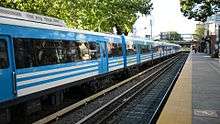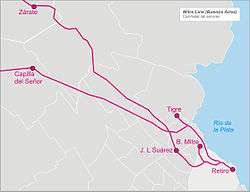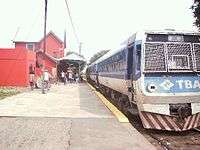Mitre Line
|
| |||||
|
| |||||
| Overview | |||||
|---|---|---|---|---|---|
| Service type | Commuter rail | ||||
| Status | Active | ||||
| Locale | Buenos Aires Province | ||||
| Predecessor | Central Argentine | ||||
| First service | 1948 | ||||
| Current operator(s) | SOFSE | ||||
| Former operator(s) | Corredores Ferroviarios | ||||
| Ridership | 18,330,500 (2014) [1] | ||||
| Website | Mitre Line | ||||
| Route | |||||
| Start | Retiro | ||||
| Stops | 57 | ||||
| End |
List
| ||||
| Distance travelled | 180 km (110 mi) | ||||
| Average journey time |
List
| ||||
| Service frequency |
List
| ||||
| Technical | |||||
| Rolling stock |
CSR EMUs (electric) Materfer CMM 400-2 (diesel) | ||||
| Track gauge | 1,676 mm (5 ft 6 in) | ||||
| Track owner(s) | Government of Argentina | ||||
| |||||
The Mitre line is an Argentine broad gauge commuter rail service in Buenos Aires Province as part of Ferrocarril General Bartolomé Mitre. The service is currently operated by State-owned company Operadora Ferroviaria Sociedad del Estado after the Government of Argentina rescinded contract with Corredores Ferroviarios in March 2015.
History
Background

The first line was built and operated by the Buenos Aires Northern Railway, a British-owned company that ran trains from Central Station (then from Retiro) to Tigre, joining both cities in 1857. The company was then taken over by the Central Argentine Railway in 1888 due to financial problems.
In 1891, Victoria station was inaugurated. Trains to Zelaya and Capilla del Señor departed from Victoria for the first time one year later. In 1916, the Retiro-Tigre line was electrified, becoming the first electrified railway system of South America. New British Thomson-Houston (BTH) multiple units were acquired to run on the line. The CAR also installed the first crossbuck and manually-operated gates in the many level crossings existing by then.
During successive years, several new stations were built by the company, such as Beccar (1913), La Lucila (1933), Acassuso (1934) and Virreyes (1938).
Ferrocarriles Argentinos

| Mitre Line | |||||||||||||||||||||||||||||||||||||||||||||||||||||||||||||||||||||||||||||||||||||||||||||||||||||||||||||||||||||||||||||||||||||||||||||||||||||||||||||||||||||||||||||||||||||||||||||||||||||||||||||||||||||||||||||||||||||||||||||||||||||||||||||||||||||||||||||||||||||||||||||||||||||||||||||||||||||||||||||||||||||||||||||||||||||||||||||||||||||||||||||||||||||||||||||||||||||||||||||||||||||||||||||||||||||||||||||||||||||||||||||||||||||||||||||||||||||||||||||||||||||||||||||||||||||||||||||||||||||||||||||||||||||||||||||||||||||||||||
|---|---|---|---|---|---|---|---|---|---|---|---|---|---|---|---|---|---|---|---|---|---|---|---|---|---|---|---|---|---|---|---|---|---|---|---|---|---|---|---|---|---|---|---|---|---|---|---|---|---|---|---|---|---|---|---|---|---|---|---|---|---|---|---|---|---|---|---|---|---|---|---|---|---|---|---|---|---|---|---|---|---|---|---|---|---|---|---|---|---|---|---|---|---|---|---|---|---|---|---|---|---|---|---|---|---|---|---|---|---|---|---|---|---|---|---|---|---|---|---|---|---|---|---|---|---|---|---|---|---|---|---|---|---|---|---|---|---|---|---|---|---|---|---|---|---|---|---|---|---|---|---|---|---|---|---|---|---|---|---|---|---|---|---|---|---|---|---|---|---|---|---|---|---|---|---|---|---|---|---|---|---|---|---|---|---|---|---|---|---|---|---|---|---|---|---|---|---|---|---|---|---|---|---|---|---|---|---|---|---|---|---|---|---|---|---|---|---|---|---|---|---|---|---|---|---|---|---|---|---|---|---|---|---|---|---|---|---|---|---|---|---|---|---|---|---|---|---|---|---|---|---|---|---|---|---|---|---|---|---|---|---|---|---|---|---|---|---|---|---|---|---|---|---|---|---|---|---|---|---|---|---|---|---|---|---|---|---|---|---|---|---|---|---|---|---|---|---|---|---|---|---|---|---|---|---|---|---|---|---|---|---|---|---|---|---|---|---|---|---|---|---|---|---|---|---|---|---|---|---|---|---|---|---|---|---|---|---|---|---|---|---|---|---|---|---|---|---|---|---|---|---|---|---|---|---|---|---|---|---|---|---|---|---|---|---|---|---|---|---|---|---|---|---|---|---|---|---|---|---|---|---|---|---|---|---|---|---|---|---|---|---|---|---|---|---|---|---|---|---|---|---|---|---|---|---|---|---|---|---|---|---|---|---|---|---|---|---|---|---|---|---|---|---|---|---|---|---|---|---|---|---|---|---|---|---|---|---|---|---|---|---|---|---|---|---|---|---|---|---|---|---|---|---|---|---|---|---|---|---|---|---|---|---|---|---|---|---|---|---|---|---|---|---|---|---|---|---|---|---|---|---|---|---|---|---|---|---|---|---|---|---|---|---|---|---|---|---|---|---|---|---|---|---|---|---|---|---|---|---|---|---|---|---|---|---|---|---|---|---|---|---|---|---|---|---|---|---|---|---|---|---|---|---|---|---|---|---|---|---|---|---|---|---|---|---|---|---|---|---|---|---|---|---|---|---|
Legend | |||||||||||||||||||||||||||||||||||||||||||||||||||||||||||||||||||||||||||||||||||||||||||||||||||||||||||||||||||||||||||||||||||||||||||||||||||||||||||||||||||||||||||||||||||||||||||||||||||||||||||||||||||||||||||||||||||||||||||||||||||||||||||||||||||||||||||||||||||||||||||||||||||||||||||||||||||||||||||||||||||||||||||||||||||||||||||||||||||||||||||||||||||||||||||||||||||||||||||||||||||||||||||||||||||||||||||||||||||||||||||||||||||||||||||||||||||||||||||||||||||||||||||||||||||||||||||||||||||||||||||||||||||||||||||||||||||||||||||
| |||||||||||||||||||||||||||||||||||||||||||||||||||||||||||||||||||||||||||||||||||||||||||||||||||||||||||||||||||||||||||||||||||||||||||||||||||||||||||||||||||||||||||||||||||||||||||||||||||||||||||||||||||||||||||||||||||||||||||||||||||||||||||||||||||||||||||||||||||||||||||||||||||||||||||||||||||||||||||||||||||||||||||||||||||||||||||||||||||||||||||||||||||||||||||||||||||||||||||||||||||||||||||||||||||||||||||||||||||||||||||||||||||||||||||||||||||||||||||||||||||||||||||||||||||||||||||||||||||||||||||||||||||||||||||||||||||||||||||
When the Government of Argentina led by Juan Perón nationalised British and French railway companies in 1948, state-owned company Ferrocarriles Argentinos took over all the railway lines in the country.
In 1962, the 7131, a railcar manufactured by FIAT Concord, made its debut in the Villa Ballester-Zárate and Victoria-Capilla del Señor sections of Ferrocarril Mitre, then managed by Ferrocarriles Argentinos. Those light cars replaced Ganz Works railcars that had been run on those lines since 1938.[2]
The lack of maintenance of the FIAT 7131 coaches made some of them were out of service, so in 1987 Ferrocarriles Argentinos acquired new light railcars for the Zárate and Capilla del Señor branches. The company bought 8 units made by Materfer and soon nicknamed Pitufos (a Spanish translation for "Smurfs" due to their small size). Nevertheless, the few capacity of seats and poor damping of those units made the 7131 remained active.[2]
Privatisation: TBA
FA operated the trains until 1991 when residual company FEMESA temporarily took over all the urban services prior to be privatized. After the Government of Carlos Menem privatized the urban railways services private company Trenes de Buenos Aires (TBA) took over Mitre Line.
When the Government of Argentina decided to privatize all the urban railway services in 1992, the Mitre Line was given in concession to Trenes de Buenos Aires (or TBA, which also took over Sarmiento Line) through Decree N° 730/95.
During the first two years of concession, TBA met the requeriments specified on the contract, about the frequency of the service, with an average of 98%. By February 1999 the consortium had invested USD 200 million including the reconstruction of 220 Toshiba wagons, the remodelation of 13 stations and workshops. In addition, a new ticket selling system was introduced with the installation of vending machines.
One of the most notable improvements was the introduction of "Puma" coaches in the Retiro-Tigre branch. This coaches were built by local factory Emprendimientos Ferroviarios S.A. (EMFER) and featured air conditioning, ABS brakes and computer-supervising systems.[3]
In 1997 the Government decided to modify the contracts of concession with a plan of modernization for USD 2,500 million. The future investments required to acquire 492 brand-new electric multiple units, refurbishing of more than 100 km of existing tracks, and the installation of new signalling, among other improvements.
Nevertheless, the Government of Fernando De la Rúa (who had come to power in 1999) made changes to the original project, reducing the amount of the budget to USD 1,300 million. To a compensation to the companies, the State granted subsidies to TBA (and the rest of the private operators) as a way to compensate the losses and avoid tariffs to increase.
Due to this politic and the lack of investments in Mitre Line, the quality of the service decreased considerably. TBA operated the line until the 2012 Once station rail disaster happened. As a result, the National Government revoked the concession granted to TBA and gave the Mitre and Sarmiento to State operator UGOMS, that run the line until 2014 when it was given under concession to Corredores Ferroviarios.[4][5][6]
New concession

On February 12, 2014, the Government of Argentina granted the operation of the line to private company Corredores Ferroviarios.[4][5][6] That same year the Government announced the acquisition of new coaches to increase the Mitre Line rolling stock. The coaches were manufactured by Chinese company CSR Corporation Limited, the first arrived in June 2014.[7][8]
In November 2014, the Retiro-Tigre section of Mitre Line renewed its fleet of electric trains, adding a total of 12 brand new trains for that service. The CSR trains replaced old Toshiba cars that had been brought to Argentina in the 1960s for the Mitre and Sarmiento lines. The purchase cost $ 250 million, all paid by the National Government.[9][10]
Branch to José L. Suárez's fleet was renewed completely with the same Chinese trains in January 2015.[11][12]
Renationalisation
State-owned company Operadora Ferroviaria Sociedad del Estado took over Mitre line (operated by Corredores Ferroviarios) after the Government of Argentina rescinded the contracts signed with the company on March 2, 2015. The contract terms specified that the concession could be cancelled with no right to claim compensation.[13] The agreements had been signed in February 2014, committing Argentren and Corredores Ferroviarios to operate the lines.[14][15][16]
Train services
Current Mitre Line services as of February, 2015:
| Start | End | Km. | Type |
|---|---|---|---|
| Retiro | Tigre | 30 | Electric |
| B. Mitre | 15 | ||
| José León Suárez | 27 | ||
| Victoria | Capilla del Señor | 60 | Diesel |
| Villa Ballester | Zárate | 75 |
Gallery
 Old Tigre station, c. 1900, now a boat station
Old Tigre station, c. 1900, now a boat station New Tigre train station, opened in 1995
New Tigre train station, opened in 1995 Retiro Mitre hall
Retiro Mitre hall Zelaya station
Zelaya station Materfer CMM 400-2 used for diesel services
Materfer CMM 400-2 used for diesel services
 CSR EMU arriving at Rivadavia station
CSR EMU arriving at Rivadavia station
See also
Notes
References
- ↑ Estadísticas del transporte ferroviario - Total 2014, CNRT website - Ministry of Transport
- 1 2 Historia del Ferrocarril al Norte del Gran Buenos Aires: Ferrocarriles Mitre y Belgrano by Ariel Bernasconi - Dunken Editorial (2012) - ISBN 978-9870257691
- ↑ Detalle de los coches Puma en sitio web de EMFER (Archive)
- 1 2 "Trenes: le dan a Roggio el Mitre y el San Martín y a Emepa, el Roca y el Belgrano Sur", La Nación, 12 Feb 2014
- 1 2 "Las privadas volverán a operar la mayoría de las líneas ferroviarias", Clarín, 12 Feb 2014
- 1 2 "El Gobierno estableció un nuevo régimen de operaciones de las líneas ferroviarias", Telam, 12 Feb 2014
- ↑ "CSR fleet enters service in Buenos Aires", Railway Gazette International, 10 June 2013
- ↑ "Ya está en viaje la primera de las 25 formaciones para la línea Sarmiento", Telam, 7 Jan 2014
- ↑ "Llega el nuevo tren Mitre: en diez días ya circularán doce formaciones chinas", La Nación, 16 Nov 2014
- ↑ Clarin.com "Los nuevos trenes del Mitre: asombro en los pasajeros y viajes más cómodos", Clarín, 26 Nov 2014
- ↑ "A partir de hoy, el Mitre ramal Suárez tiene trenes nuevos", Infobae, 26 Jan 2015
- ↑ "Desde hoy corren trenes nuevos en el ramal Suárez del Mitre", Clarín, 26 Jan 2015
- ↑ "Ya está lista la ley que prevé más control estatal sobre los trenes", Clarín, 5 Mar 2015
- ↑ "Estado rescindió contrato de trenes a privados y avisó que no pagará indemnizaciones", Ambito Financiero, 2 Mar 2015
- ↑ "Buenos Aires commuter routes renationalised", Railway Gazzette, 3 Mar 2015
- ↑ Resolution N° 171/2015 - Official Bulletin of Argentina
External links
| Wikimedia Commons has media related to Ferrocarril General Bartolomé Mitre. |
- Official website
- Corredores Ferroviarios (former operator)
- Mitre-Sarmiento website (Archive)



